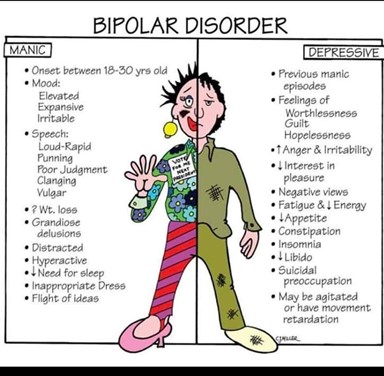An acute mental health whit is admitting a client who has bipolar disorder. Which of the following findings supports the admitting diagnosis of acute mania?
The client responds to questions with disorganized speech.
The client reports that voices are telling him to write a novel.
The client's spouse reports that client has recently gained weight.
The client is dressed in all black.
The Correct Answer is A
A. The client responds to questions with disorganized speech:
Disorganized speech is a hallmark of acute mania, often reflecting racing thoughts, pressured speech, and difficulty staying on topic.
B. The client reports that voices are telling him to write a novel:
Reporting that voices are telling the client to write a novel suggests auditory hallucinations, which can occur in various psychiatric conditions, not specifically indicative of acute mania.
C. The client's spouse reports that the client has recently gained weight:
Weight gain is not a typical hallmark of acute mania. In fact, during manic episodes, individuals might experience decreased appetite and sleep, leading to potential weight loss.
D. The client is dressed in all black:
Dressing in all black is not a specific sign of acute mania. While changes in clothing choices or appearance can sometimes be associated with mood changes, this finding alone is not indicative of acute mania.

Nursing Test Bank
Naxlex Comprehensive Predictor Exams
Related Questions
Correct Answer is C
Explanation
A. Antidepressants usually take several weeks to start taking effect, so the statement "I can be on my antidepressant taking three to five days to be effective" is not correct.
B. While positive thinking can play a role in managing mood, depression is a complex disorder that often requires more than just positive thoughts to treat. The statement "I can cure my depression by thinking positive thoughts" oversimplifies the condition.
C. "I will attend psychotherapy to help manage my depression."
Explanation:
Depressive disorders, including major depression, are complex conditions that typically require a multifaceted approach to treatment. Psychotherapy, also known as talk therapy, is an important component of treating depression. It involves working with a trained therapist to explore and address the thoughts, feelings, and behaviors contributing to the depression. Psychotherapy can help individuals develop coping strategies, improve problem-solving skills, and gain insight into their condition.
D. Depression is not something that can be simply chosen to be stopped voluntarily. It is a mental health disorder that often requires professional treatment and support. The statement "I need to make a voluntary choice to stop feeling depressed" does not accurately capture the nature of depression.
Correct Answer is C
Explanation
A. Discuss the problem in a community meeting with the other clients on the unit present.
While open communication and community meetings can be valuable in certain situations, discussing a client's disruptive behavior in front of others may breach their privacy and dignity. It's important to address such matters privately and respectfully.
B. Escort the client to her room each time the nurse observes the client socializing with other clients.
This action might be seen as overly punitive and restrictive. Isolating the client based on their behavior without addressing the underlying issues doesn't promote a therapeutic approach to the situation.
C. Talk to the client and identify the specific limits that are required of the client's behavior.
This is the correct option. Talking to the client directly allows the nurse to address the behavior, express expectations, and set clear boundaries. This approach promotes open communication and gives the client a chance to understand how their actions are affecting others.
D. Tell the other clients to ignore the client's lies.
While it's important to encourage other clients to manage their reactions to disruptive behavior, simply telling them to ignore lies might not address the root cause of the issue. The nurse should aim to address the behavior itself and create an environment where all clients feel respected and safe.
Whether you are a student looking to ace your exams or a practicing nurse seeking to enhance your expertise , our nursing education contents will empower you with the confidence and competence to make a difference in the lives of patients and become a respected leader in the healthcare field.
Visit Naxlex, invest in your future and unlock endless possibilities with our unparalleled nursing education contents today
Report Wrong Answer on the Current Question
Do you disagree with the answer? If yes, what is your expected answer? Explain.
Kindly be descriptive with the issue you are facing.
